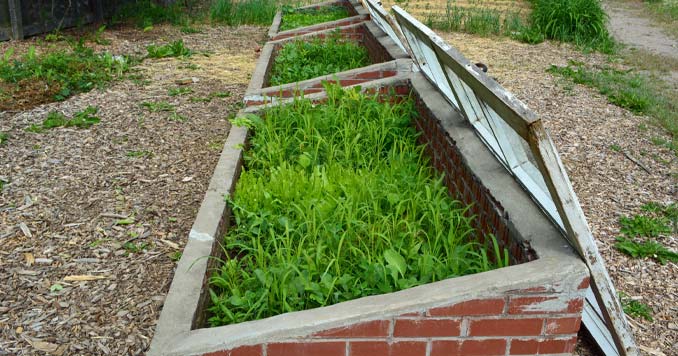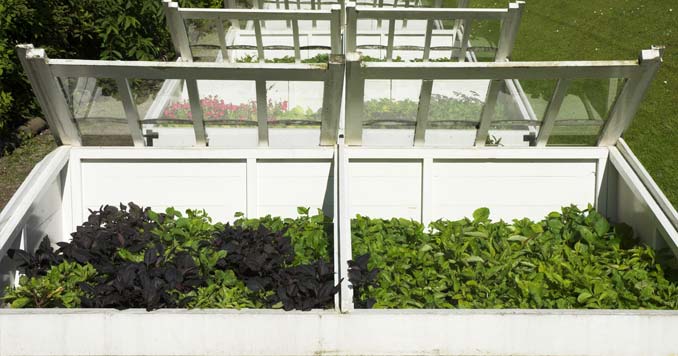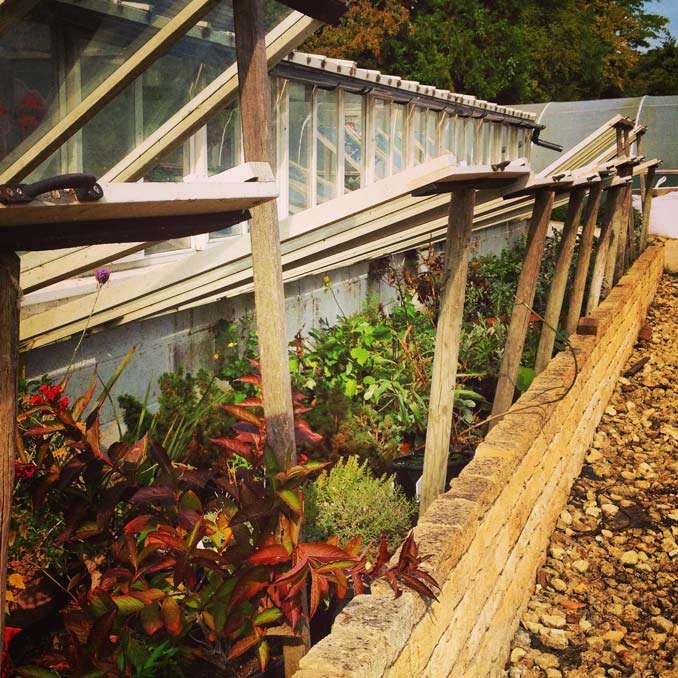Toward the end of summer or early fall, it may seem too early to start thinking about winter. And it may be too late to start thinking about a solid harvest. But when it comes to survival, you’ll need to consider the importance of surviving through winter and what you can do now to survive long-term.
Sure, hunting or fishing might get you by if you’re skilled enough. And food stores might help to supplement any fresh kill or frozen meats. But the real challenge is providing yourself and your family with access to fresh food in the dead of winter that can not only get you through winter, but also springboard your garden next summer.
This is where the cold frame comes in.
What is a Cold Frame?

For the purposes of gardening, a cold frame is a transparent-roofed enclosure that is used to protect plants from cold weather. The transparent top of the enclosures allows sunlight into the box while preventing heat from escaping.
This simple device is a proven method for growing fresh food through winter and priming summer gardens earlier than weather permits. They take less space than a traditional garden, require less maintenance, and have the potential to provide far more food than the empty produce section at a supermarket.
The Benefits of Cold Frame Gardening and Food Growing
Cold frames are essential in every long-term survival skill set. These simple, yet effective exoskeletons help to extend the harvest timeline well beyond the first frost of the year. This means an early or late winter doesn’t impact your food supply as much as it does other people. During times when food is scarce and access is limited, a cold frame can provide fresh produce essential to survival. Valuable spices and herbs aid in adding flavor to otherwise bland foods. They can be dehydrated or serve as barter items. Plus, you and your family can have access to natural fiber, vitamins, and minerals essential to a healthy diet.

Cold frames help to promote an early growing period. Regions that have late frosts have to delay planting much longer, which creates a much shorter growing season. But with cold frames, starts can begin much earlier without the need for a giant greenhouse. Transplants from a cold frame have a greater potential to produce than if you were to wait until the last freeze of the year.
Beyond the dangers of early or late frosts, some of the benefits of a cold frame include less stress on plants, protection from wind, less erosion, fewer weeds, and easy access. If properly oriented and built with care, these units can keep plants alive longer, allow sowing sooner, and generate food during the darkest days.
The Harvest: What you can grow in a Cold Frame Enclosure

It’s possible to harvest leafy plants like lettuce, kale, and chard well into the depths of winter and produce hearty starts in early fall where direct sowing is too risky. Plants like potatoes, carrots, radishes, and beets are also good candidates for cold frames, along with bulb plants. The greens and root vegetables available through proper maintenance and care can easily supplement a protein- and carbohydrate-rich diet for those who fall back on food stores to get by.
During the winter season, when no one has access to fresh vegetables from their own gardens, supermarkets generally pull from frozen stockpiles or other regions of the world to fill their produce sections. But when supply chains fail, or when thawed vegetables reveal latent bacteria, food recalls and food-borne illnesses become more prominent. Some fresh foods become more expensive, or in some cases non-existent.
By taking what’s left of your seed stock, or rounding up the end-of-season bargain seeds, you can easily supplement your fresh vegetables instead of relying on what’s left on the shelves. Instead, you can trudge through the snow, open a cold frame and pluck what you need right out of the ground as if it were mid-summer. No chemicals, no bugs, no weeds. Just fresh food that is homegrown and ready to eat after a quick rinse. This ease of access and redundancy helps by reducing the need to tap into canned food. Your canned food stores will have greater longevity and could serve a dual purpose as barter if needed for other time-sensitive supplies. Meanwhile, you’ll be able to replace your supply behind the scenes.
The Build: How to build a Cold Frame Garden Box

The frame itself is dirt simple. The concept centers around retaining heat in the soil to allow plants to grow despite snow, frost, or even frozen ground nearby. Frames retain heat by absorbing sunlight in an enclosed space, much like a greenhouse. It can be as basic as a 2-liter bottle over a plant, or as complex as a conservatory. The most effective form for small-scale home gardens is a rectangular box about 2’ wide by 3-4’ long.
To create a cold frame, first locate a piece of un-tinted, single-pane glass such as an old wooden window or aluminum storm window. Anything before the era of vinyl windows will work well. Double-paned windows often contain Argonne gas or tinting that may interfere with natural sunlight, heat gain, or heat loss. If you’re handy in the shop, you may be able to build your frame out of wood and order up the glass to fit from a glass shop in your area. Clear corrugated plastic also serves the same purpose – let light in and keep the cold out.
If you are looking for something that will hold up better than glass, I suggest cheking out Lexan — this stuff can be shot with a .22lr bullet and not break!
The glass, Lexan, or clear plastic goes on top of an exterior framework. The framework consists of a simple, low-profile box that can be made of 2X6 studs or even plywood. Wood is joined and secured at the corners to provide a box that rests directly on the ground. Just remember – the thicker the wood, the better the insulation will be. Alternatives to wood frames might include brick, foam, or insulated metal siding. Regardless of the materials used to create the framework, you’ll want to build it to match the size of the window or glass frame you intend to use. You may be able to add hinges to lift the glass for access or install a repurposed sliding glass window.
You should have a rectangle of wood framework with a glass panel or frame on top that can be lifted or opened for access. Now, orient the glass to where the longest side runs parallel to the equator. You want to capture as much sunlight as possible and if snow or rainwater is an issue, adding a slope to the frame will make snow removal and access much easier. The orientation and a good slope will garner the best results possible.
Once the frame is built, oriented and set in place on the ground, you can remove dirt a few inches down and either direct-sow your plants or provide a layer of compost to help get the seedlings started. By starting in late summer or early fall, you’ll have better luck with a regular harvest in mid-winter. By sowing in late winter or early spring, you’ll have heartier plants to transplant into your survival garden during summer.
If extreme temperatures or limited sunlight prevents the cold frame from heating up, you can add a light, heat tape, a heating mat, or additional insulation around the frame to aid in heat retention. Zones 1 through 5 will likely need more insulation and lighting than zones 6-10. Additional insulation can be obtained through foam, additional wood, or even organic insulation like grass clippings or seedless yard waste.
Unlike a greenhouse, a cold frame allows for a heightened level of discretion. The low-profile design is easy to disguise with shrubs or debris to prevent theft in times of chaos. This means that even in an urban setting, with limited space and relatively high visibility, you could still maintain a solid level of security and still have access to fresh food.
If you’re just getting started, and want to test the concept out before comitting to an entire cold frame system, you can pick up premade frame systems for under $75 — here’s a decent one to get you started.
For something more permanent, that really blends into your landscaping, we suggest going the extra step and using a brick frame or building your system into an existing retaining or privacy wall.
The History of Cold Frame Gardening

Cold frames have been around for centuries, but only recently have they been re-introduced as a viable resource for small-scale winter food production. With the advent of the supermarket, people gained access to foods not typically available year-round. Before supermarkets, home and community gardens served to feed people year-round as a result of proper gardening practices and preservation techniques.
The cold frame origins date back to the Greeks, who used translucent mica sheets to produce a greenhouse effect for growing vegetables year-round. Mica was later replaced with leaded glass to create the greenhouses we’re familiar with today. But while greenhouses and conservatories evolved and served their purpose through the ages to the wealthy and powerful, cold frames became the standard for the backyard gardener who needed to survive no matter what.
Now that food quality, freshness, and preservation are being questioned in supermarkets, more and more people are seeking alternatives. The cold frame provides even the novice gardener an opportunity to grow food with limited resources in the harshest conditions. With limited supplies and a moderate level of skill, anybody can install and sow a cold frame in almost no time.
Stockpiling food and resources prior to an emergency or catastrophic event will help you survive. But being able to provide for yourself when grocery stores are no longer available is a survival skill worth its weight in gold.



A cold frame garden would definitely be handy to have in a SHTF situation. And the sooner you get it going, the better!
Sadly, the price of the under $75 cold frame is now $119 in November 2021. The quality may have slipped also, just a heads up.